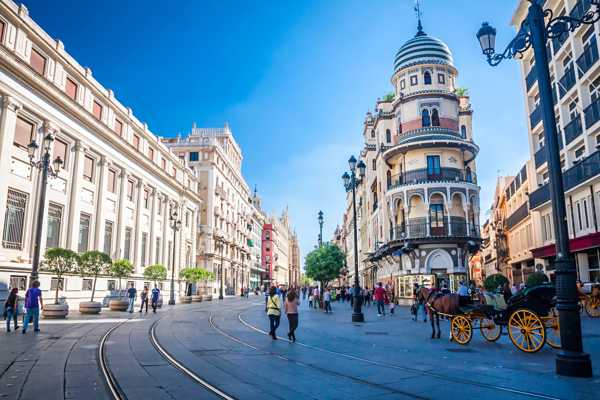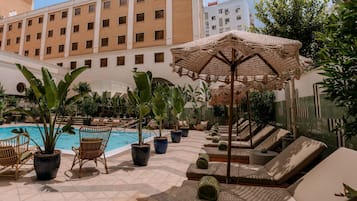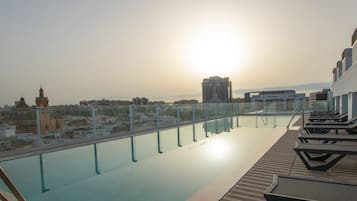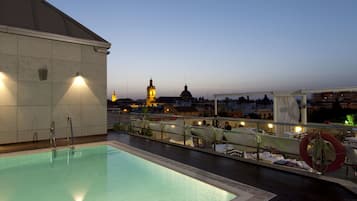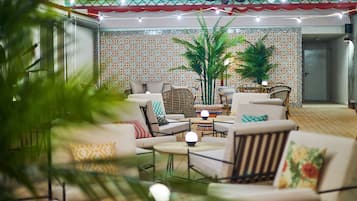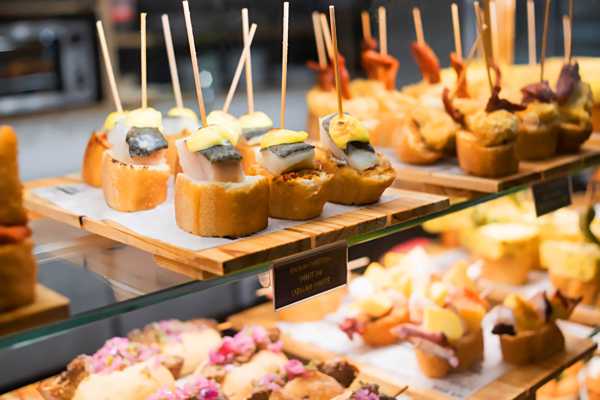The most popular neighbourhoods in Seville are located around its old town and cultural hotspots. In this compact city filled with historic landmarks, no neighbourhood is a bad neighbourhood and a great tapas bar can be found just about anywhere. But depending on your interests and preferences, there’s surely an area that’s best for you.
For proximity to the city’s top attractions, choose Santa Cruz, El Arenal or El Centro. If it’s a more local experience you’re after, opt for Triana, the working-class neighbourhood where Seville’s ceramics production and flamenco dance came to life. Other districts offer more nightlife, more avant-garde culture or more greenspaces.
- 1
Triana
The birthplace of Andalusian art forms

- Νυχτερινή ζωή
Away from the city’s main tourist attractions across the Guadalquivir River lies Triana, one of Seville’s most traditional and lively neighbourhoods. Historically home to artists and the working class, you’ll find the bars here open late and packed with locals. Head to the colourful Calle Betis to find family-run tapas bars along the riverside.
Much of the city’s culture developed here, from flamenco and bullfighting to ceramics production. Flamenco dancers put on spontaneous late-night performances. Fading posters of legendary matadors like Juan Belmonte, a resident of Triana, hang on the walls of old tapas bars.
- 2
Santa Cruz
Old-World romance in the historic centre

- Ζευγάρια
- Ιστορία
No trip to Seville is complete without a visit to Santa Cruz. Situated in the city’s heart between 2 of its most important sites, the area is packed with tourists but somehow retains an Old-World neighbourhood feel. It’s a delight just to wander around its web of little streets paved with cream-coloured cobblestone. Punctuate your exploration with rest in tree-lined squares and cosy sidewalk cafes.
The city’s old Jewish quarter, Santa Cruz is filled with history. The Moorish bell tower of the city’s grand Gothic cathedral reaches high above the rooftops. On the other side of the neighbourhood is the Royal Alcázar, an ornate Moorish palace that is a registered UNESCO World Heritage Site.
- 3
Macarena
Home to the city’s oldest market

- Οικονομική διαμονή
- Ιστορία
In the last 2 decades, Macarena has transformed from one of the city’s poorest areas to a hip hub for the younger crowd. North of the historic centre, it was part of Seville’s old city and is filled with beautiful architecture. The largest remaining sections of the original Moorish city wall, built in the 12th century, are found here as well.
While you’re in the neighbourhood, don’t miss Mercado de la Feira, the city’s longest-running market. It’s filled with fresh fruit stalls, pastelerías and little bars selling ceviche and pescado frito. Popular with students, Macarena has great inexpensive restaurants and is a good place to stay if you’re travelling on a budget.
- 4
El Arenal
An old town neighbourhood with an infamous bullring

- Ιστορία
El Arenal is the part of Seville’s old town surrounding Plaza de Toros de la Maestranza, the city’s famous bullring. The largest and most important in Spain, the striking Baroque structure was built in the 18th century and can seat 13,000 spectators. Even if you disagree with the bullfighting tradition, the building is worth a visit for its history.
This neighbourhood is home to several other important monuments, including the 12th-century Torre del Oro and the impressive Plaza del Cabildo. The lovely baroque Hospital de la Caridad today houses paintings by Spanish Masters. With so many of the city’s top attractions within walking distance, plus the area’s excellent tapas bars, El Arenal serves well as a traveller’s home base.
- 5
Los Remedios
Tree-lined boulevards define this upscale neighbourhood

- Καταναλωτές
Located south of Triana on the other side of the River Guadalquivir, Los Remedios is an upscale commercial neighbourhood with a different look from the rest of the city. Wide, straight boulevards replace the narrow, winding streets. The neighbourhood green space, Parque de los Príncipes, is a lovely picnic spot.
The Feira de Abril, Seville’s most famous festival, takes place here each year in late April. The fairground fills with colourful casetas selling local dishes like fried squid with garlic mayonnaise. Women dress in vibrant ruffled flamenco dresses, and horse-drawn carriages parade through the grounds. It’s one entire week of drinking, dancing and celebrating Seville’s culture.
- 6
Alameda
Seville’s diverse hub of contemporary culture

- Οικονομική διαμονή
- Νυχτερινή ζωή
Alameda de Hércules has a lively, bohemian atmosphere. It’s located near the Macarena district and is equally popular with the youth of Seville. There are lots of chic bars, vintage shops and live music venues (it is said that Andalusian rock was invented here). The neighbourhood is centred around the long, rectangular town square of the same name, where locals can be found having drinks and socialising in the evenings.
This is the city’s most open-minded neighbourhood. It’s home to much of the LGBTQ+ community and the birthplace of Seville’s most interesting social and cultural movements. Maybe this is why there are so many funky spots, like coffee-bar-slash-bookstore La Gata en Bicicleta and neon-lit 80s bar 1987.
- 7
Nervión
The well-connected local favourite

- Καταναλωτές
If you’re arriving in Seville by train, your first impression of the city is likely to be Nervión. Extremely well-connected by public transportation, this a highly sought-after neighbourhood for residents. The architecture is a mix of modern and regionalist. This early 20th-century movement produced stunning new styles through the reinterpretation of Seville’s historic styles and the use of local craft.
Ramón Sánchez-Pizjuán Stadium, home of the Sevilla Football Club, is located here too. On game nights, neighbourhood bars fill with enthusiastic fans. Nervión Plaza is one of the city’s major shopping centres, covering 25,000 square metres and including many restaurants and a 20-screen cinema.
- 8
Alfalfa
Where avant-garde meets historic charm

- Νυχτερινή ζωή
- Καταναλωτές
Neighbouring the popular Santa Cruz, Alfalfa has the same historic charm with an added dose of idiosyncratic cool. Exploring the narrow alleyways here you’ll find funky independent shops and artsy coffeehouses mixed in with the tapas bars. These forward-thinking shop owners are selling street fashion, unusual jewellery and original artwork.
A particularly interesting part of the neighbourhood is Soho Benita, a cluster of shops and bars near the enormous, mushroom-like Metropol Parasol. Many restaurants in the area serve international food, some focusing on vegetarian and organic options. On weekends after dark, this area turns into a botellón, a raucous street party.
- 9
El Centro
A shoppers' heaven

- Φαγητό
- Καταναλωτές
Historic El Centro is Seville’s bustling commercial centre, with tons of shopping and dining options as well as easy access to the landmarks of the old city. The area is highly walkable. At its northern end, you’ll find a branch of Spain’s most popular department store, El Corte Inglés, as well as international staples like Zara and Pull&Bear. On Calle Sierpes and Calle Tetuan, small shops sell traditional items like flamenco dresses and lace fans.
For your daily dose of culture, visit the Museo Nacional de Bellas Artes, one of Spain’s most important art museums. Housed in a 17th-century palace, the collection features artworks from the medieval period through to the early 20th century, highlighting works by Spanish Masters.
- 10
Distrito Sur
The city’s most beautiful park and plaza

- Ιστορία
Distrito Sur is one of the city’s largest and most varied districts. Its primary appeal to visitors is that it’s largely residential and offers a quieter stay away from the bustling city centre.
The Prado-Parque María Luisa neighbourhood, which borders the old city, houses the stunning Plaza de España. One of the most famous landmarks in Spain, the enormous plaza was built for the Ibero-American Exhibition of 1929, a world’s fair held to improve Spain’s relations with its former colonies. The adjacent Maria Luisa Park was also revitalised in preparation for the exhibition, and today is a charming green expanse of orange trees and ceramic-tiled fountains.

